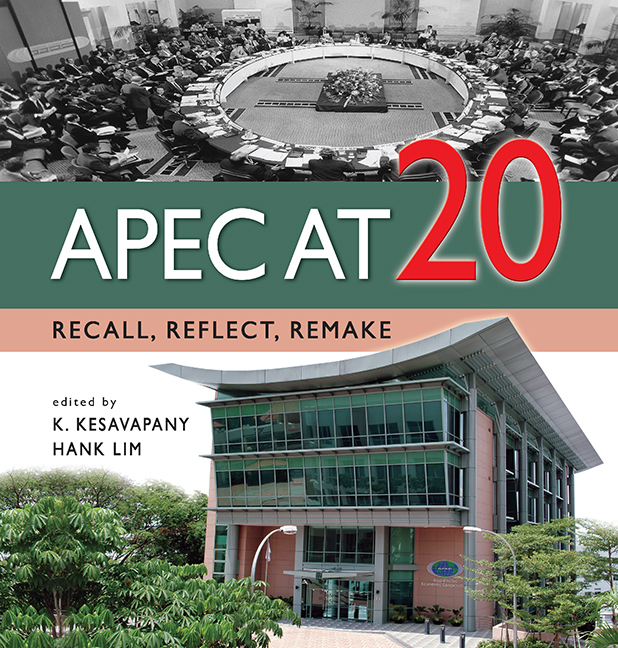Book contents
- Frontmatter
- Frontispiece
- contents
- Foreword by Ambassador Michael Tay
- Preface
- About the Authors
- Asia-Pacific Economic Cooperation (APEC)
- CHAPTER 1 APEC: Genesis and Challenges
- CHAPTER 2 APEC's Origins and its Future
- CHAPTER 3 Four Adjectives Become a Noun: APEC The Future of Asia-Pacific Cooperation
- CHAPTER 4 APEC's Eye on the Prize: Participants, Modality, and Confidence-Building
- CHAPTER 5 APEC: Taking Stock and Looking Ahead
- CHAPTER 6 Revamping APEC's Concerted Unilateral Liberalization
- CHAPTER 7 APEC at 20: Assessment of Trade/Investment Liberalization, Facilitation and Ecotech Activities
- CHAPTER 8 Integrating the Business Community in the APEC Process: Genesis of the Pacific Business Forum
- APPENDICES
- Index
CHAPTER 6 - Revamping APEC's Concerted Unilateral Liberalization
from Asia-Pacific Economic Cooperation (APEC)
Published online by Cambridge University Press: 21 October 2015
- Frontmatter
- Frontispiece
- contents
- Foreword by Ambassador Michael Tay
- Preface
- About the Authors
- Asia-Pacific Economic Cooperation (APEC)
- CHAPTER 1 APEC: Genesis and Challenges
- CHAPTER 2 APEC's Origins and its Future
- CHAPTER 3 Four Adjectives Become a Noun: APEC The Future of Asia-Pacific Cooperation
- CHAPTER 4 APEC's Eye on the Prize: Participants, Modality, and Confidence-Building
- CHAPTER 5 APEC: Taking Stock and Looking Ahead
- CHAPTER 6 Revamping APEC's Concerted Unilateral Liberalization
- CHAPTER 7 APEC at 20: Assessment of Trade/Investment Liberalization, Facilitation and Ecotech Activities
- CHAPTER 8 Integrating the Business Community in the APEC Process: Genesis of the Pacific Business Forum
- APPENDICES
- Index
Summary
Introduction
The opportunity will not come twice for countries in the diverse Asia-Pacific region to engage in a productive regional trade agenda as provided by APEC's Concerted Unilateral Liberalization (CUL). This unique approach has found its manifestation in the annual submission of Individual Action Plans (IAPs) covering 15 areas of trade and investment liberalization and facilitation. They were first introduced in 1996 as the principal mechanism to realize the Bogor Goals of “free and open trade and investment in the region” by 2010 for the developed members and 2020 for the developing members of APEC.
The 1994 APEC Bogor Goals “is to this day APEC's best known and most important decision” (Damond 2003, p. 89). It was the apex of a strong process that began with the first APEC Economic Leaders Meeting on Blake Island (Seattle) that articulated the vision of the Asia Pacific as a region of free trade and investment. The following year, when APEC leaders reconvened in Bogor (Indonesia), they committed themselves to creating “free and open trade and investment in the region” by a certain date. In arriving at this decision, the leaders were assisted by an Eminent Persons Group (EPG) that produced three consecutive reports (APEC 1993, 1994, 1995). The EPG worked closely with a group of “sherpas” that directly assisted the leaders.
It was this “leaders track” that produced the bold initiative, but the modality to implement the Bogor Goals was crafted through a process within the “normal track” in APEC. This process, managed by Ministers and Senior Officials, did interact intensively with various “second track” activities like the Pacific Economic Cooperation Council (PECC), the Pacific Basin Economic Council (PBEC), as well as a multicountry group of scholars organized by the Australia-Japan Research Centre at the Australian National University. This process has led to the formulation andadoption of APEC's concerted unilateral approach in 1995 that defines the Osaka Action Agenda (OAA) and became the main modality to realize the Bogor Goals. Subsequently, at the 1996 meeting the leaders endorsed the Manila Action Plan for APEC that marked the beginning of the OAA's implementation stage with the initial submission of Individual Action Plans (IAPs) by APEC members.
- Type
- Chapter
- Information
- APEC at 20Recall, Reflect, Remake, pp. 67 - 82Publisher: ISEAS–Yusof Ishak InstitutePrint publication year: 2009



